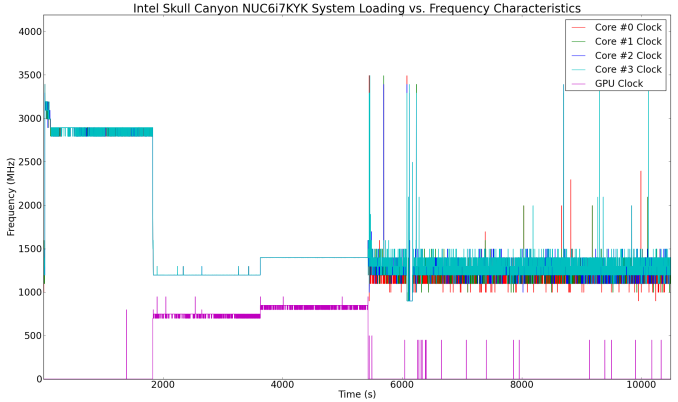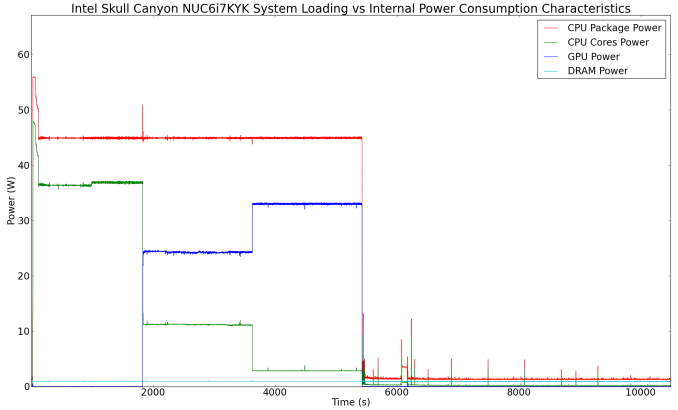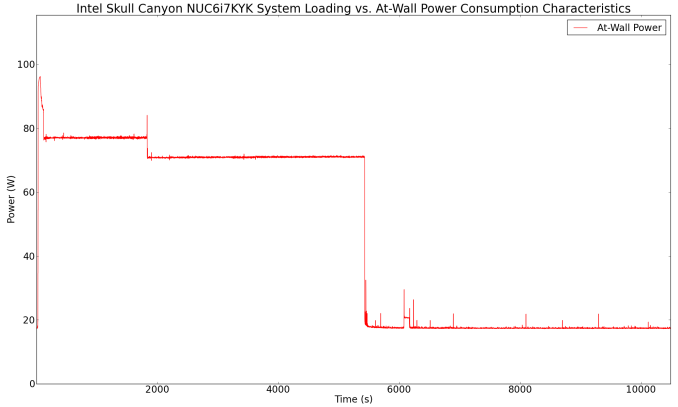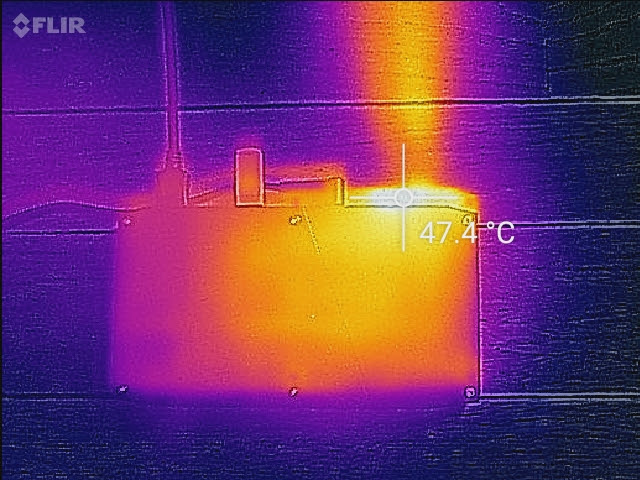The Intel Skull Canyon NUC6i7KYK mini-PC Review
by Ganesh T S on May 23, 2016 8:00 AM ESTPower Consumption and Thermal Performance
The power consumption at the wall was measured with a 1080p display being driven through the HDMI port. In the graphs below, we compare the idle and load power of the Intel NUC6i7KYK (Skull Canyon) with other low power PCs evaluated before. For load power consumption, we ran Furmark 1.12.0 and Prime95 v27.9 together. The idle number is a bit disappointing, though, I assume that a change in the BIOS to the low power profile could help improve things. Otherwise, the idle number is just slightly higher than what is typical for a system with a 45W TDP CPU and a PCIe M.2 SSD.


The load power number in the graph above is the maximum sustained value. As we can see from the graphs below, instantaneous peak numbers can go as high as 95W. Addition of bus-powered USB devices will also tend to drive up this number further.
Our thermal stress routine starts with the system at idle, followed by 30 minutes of pure CPU loading. This is followed by another 30 minutes of both CPU and GPU being loaded simultaneously. After this, the CPU load gets removed, allowing the GPU to be loaded alone for another 30 minutes. The various clocks in the system as well as the temperatures within the unit are presented below.
The graph below present the power consumption profile of various blocks in the CPU package during the course of our thermal stress. Following that, we have the power consumption at the wall for the system during the same period.
According to the official specifications, the junction temperature of the Core i7-6770HQ is 100 C. Unfortunately, the cooling solution is not able to prevent the CPU from hitting it with turbo speeds activated. However, the frequency does remain above the base 2.6 GHz throughout the pure CPU loading segment. The package power settles down to a steady 45W, and that continues throughout the duration of our test. Our only concern is that the cooling solution keeps the temperature of the cores too close to the junction temperature during periods of heavy CPU load. Once the load gets distributed across both the CPU and the GPU, we see the package come down to around 90C.
Another important aspect to keep note of while evaluating mini-PCs is the chassis temperature. Using the Android version of the FLIR One thermal imager, we observed the chassis temperature after the CPU package temperature reached the steady state value in the above graph.
We have additional thermal images in the gallery below.
The maximum chassis temperature observed by the thermal imager was slightly above 60 C near the fan's exhaust vent. At that point, a sound level Android app running on the HTC One M7 recorded 59 dB. For comparison purposes, the Zotac ZBOX MAGNUS EN970 recorded 50 dB in a similar scenario.







_thumb.jpg)

_thumb.jpg)

_thumb.jpg)









133 Comments
View All Comments
fanofanand - Monday, May 23, 2016 - link
You rebutted your own statement. Casual gamers don't buy $1k mini-PC's. Testing this at super low resolutions can only serve one purpose, which is to provide the appearance of acceptable performance.ganeshts - Monday, May 23, 2016 - link
The point with mini-PC reviews with a gaming focus is that they are spread far apart - we may be lucky to have 3 or 4 in a year.So, it boils down to what we think is more relevant to the reader - a set of benchmark numbers that have to be presented standalone, or a set of benchmark numbers which can be compared apples to apples against some similar previous-generation systems (because, that is what we have the numbers for). We think the latter makes more sense, and that is the reason we are having these 'legacy resolutions' in the gaming benchmarks.
fanofanand - Monday, May 23, 2016 - link
I completely understand why you need to present the information, I just don't think this really meets the "Skulltrail brand" expectations. Skulltrail was always an enthusiast platform designed by enthusiasts. This product looks like it fell victim to marketing requiring a certain thickness of chassis. This product waters down the skulltrail branding, though I guess skulltrail really isn't even relevant anymore. I just don't understand who this is designed for I guess.FMinus - Sunday, August 7, 2016 - link
this really isn't a low budget part, they can get similar or better performance in an ATX form factor for around ~$100 to 200 less.zepi - Monday, May 23, 2016 - link
I'd love to see a ~90W TDP version of this with CPU cores getting about 30W and GPU having 60 or so allocated for it. Even 65W TDP part would be a definite improvement for gaming as CPU / GPU clocks could stay considerably higher during loading of both parts of the chip.With proper cooling it could actually compete decently with low-end discrete graphic laptops. Now it is clear that TDP is limiting it badly.
The question is: How is the perf/w compared to for example A9x GPU parts or Maxwells? Somehow I'm not terribly impressed by Intel's GPU's. Especially considering that they've had their hugely superior manufacturing technology which should help...
Osamede - Monday, May 23, 2016 - link
Power consumption measured with a 1080p display. Is this the real use case?ganeshts - Monday, May 23, 2016 - link
Why not? Not everyone has migrated to 4K yet. I am a first-world tech reviewer, and the max. res monitor that I have is only 2560x1440 :)jhoff80 - Monday, May 23, 2016 - link
Out of curiosity, will there also be an Anandtech review of the new Core M Compute Sticks as well?jaydee - Monday, May 23, 2016 - link
Isn't is kinda a no-brainer to make this thing a little big bigger (with a little better cooling), to avoid throttling? Wouldn't just an inch taller help immensely?ShieTar - Monday, May 23, 2016 - link
Sure, but at ~55mm height it is beginning to look similar in size to a 70 mm high Mini-ITX case, which you can use to build yourself a system with similar compute power, for less than half the system cost.So it really needs to be very flat and very compact to qualify as a niche-product. Asking twice the price for just a 20% difference in some aspect is usually very hard to sell.